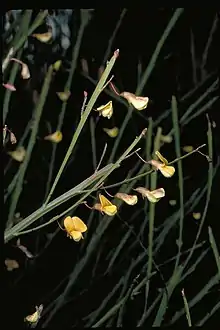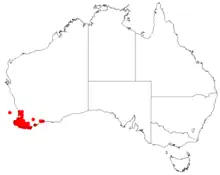| Bossiaea rufa | |
|---|---|
 | |
| Scientific classification | |
| Kingdom: | Plantae |
| Clade: | Tracheophytes |
| Clade: | Angiosperms |
| Clade: | Eudicots |
| Clade: | Rosids |
| Order: | Fabales |
| Family: | Fabaceae |
| Subfamily: | Faboideae |
| Genus: | Bossiaea |
| Species: | B. rufa |
| Binomial name | |
| Bossiaea rufa | |
 | |
| Range map generated from data at Australasian Virtual Herbarium | |
Bossiaea rufa is a species of flowering plant in the family Fabaceae and is endemic to the south-west of Western Australia. It is a loose, many-branched shrub with elliptic to egg-shaped leaves with the narrower end towards the base, and deep yellow and red flowers.
Description
Bossiaea rufa is a loose, many-branched shrub that typically grows to a height of up to 2 m (6 ft 7 in) when supported by surrounding vegetation. The stems are flattened and winged, up to 10 mm (0.39 in) wide and are sometimes leafless. The leaves, when present, are elliptic to egg-shaped with the narrower end towards the base, mostly 7–15 mm (0.28–0.59 in) long and 5–8 mm (0.20–0.31 in) wide on a petiole 1.5–4.5 mm (0.059–0.177 in) long with egg-shaped stipules 1–3 mm (0.039–0.118 in) long at the base. The flowers are arranged singly or in pairs in leaf axils on pedicels 5–10 mm (0.20–0.39 in) long, with egg-shaped bracts 1–2 mm (0.039–0.079 in) long at the base. The five sepals are 5.7–6 mm (0.22–0.24 in) long and joined at the base, forming a tube 2.0–3.6 mm (0.079–0.142 in) long, the two upper lobes 3.7–5.2 mm (0.15–0.20 in) long and the lower lobes 1.2–1.8 mm (0.047–0.071 in) long. The standard petal is deep yellow with a purplish-red base and 9.5–12.2 mm (0.37–0.48 in) long, the wings reddish and 8.1–8.9 mm (0.32–0.35 in) long, and the keel reddish and 7.2–7.5 mm (0.28–0.30 in) long. Flowering occurs from September to January and the fruit is an oblong pod 25–38 mm (0.98–1.50 in) long.[2][3][4]
Taxonomy and naming
Bossiaea rufa was first formally described in 1812 by Robert Brown in Hortus Kewensis.[5][6] The specific epithet (rufa) means "reddish-brown".[7]
Distribution and habitat
This bossiaea usually grows in sandy soil in moist places near streams and swamps in the Esperance Plains, Jarrah Forest, Mallee, Swan Coastal Plain and Warren biogeographic regions of south-western Western Australia.[2][3]
Conservation status
Bossiaea rufa is classified as "not threatened" by the Government of Western Australia Department of Biodiversity, Conservation and Attractions.[2]
References
- ↑ "Bossiaea rufa". Australian Plant Census. Retrieved 28 August 2021.
- 1 2 3 "Bossiaea rufa". FloraBase. Western Australian Government Department of Biodiversity, Conservation and Attractions.
- 1 2 Ross, James H. (2006). "A conspectus of the Western Australian Bossiaea species (Bossiaeeae: Fabaceae). Muelleria 23". Muelleria. 11: 108–110. Retrieved 28 August 2021.
- ↑ Ross, James H. (1994). "Notes on Western Australian Bossiaea species (Fabaceae): 2". Muelleria. 8 (2): 213–216. Retrieved 28 August 2021.
- ↑ "Bossiaea rufa". APNI. Retrieved 28 August 2021.
- ↑ Brown, Robert; Aiton, William (ed.) (1812). Hortus Kewensis. Vol. 1 (2 ed.). London: Longman, Hurst, Rees, Orme and Brown. p. 267. Retrieved 28 August 2021.
{{cite book}}:|first2=has generic name (help) - ↑ Sharr, Francis Aubi; George, Alex (2019). Western Australian Plant Names and Their Meanings (3rd ed.). Kardinya, WA: Four Gables Press. p. 298. ISBN 9780958034180.